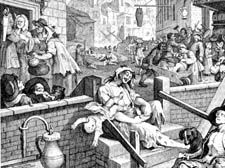|
|
 |
| |

William Hogarth’s engraving Gin Lane, 1751
|
Wallowing in capital filth
Hubbub: Filth, Noise and Stench in England. By Emily Cockayne.
Yale University Press £25
OVERCROWDING, expense, congestion, rubbish, noise, quarrels, unruly children, strangers, thieves, grime and bustle are inseparable from life in modern London. None of this is new, as Emily Cockayne shows in graphic detail in Hubbub, a survey of city and street life in England in the 17th and 18th centuries.
While London was smaller than it is nowadays, its population rising from 200,000 in 1600 to 750,000 by 1750, it was certainly more crowded. Behind the façades of the houses of the rich, where servants were crammed into damp basements or freezing garrets, was often low-quality housing reached by narrow passages.
The streets were cluttered, badly-paved, narrow and dirty, as well as being virtually unlit. Cattle, sheep and geese were driven through the streets on their way to slaughter at Smithfield. Pigs and dogs wandered freely, while carriages, carts and riders jostled passers-by and caused frequent accidents.
A walk through Stuart or Georgian London brought a sustained assault on the senses. Cheap sea coal, shipped from Newcastle, covered London in a brown smog, wrecked clothing and coated every surface. At a time before running water, flushing toilets or adequate sewerage, when the disposal of household waste was the responsibility of the individual householder, huge amounts of human and animal excrement had to be disposed of.
Mount Pleasant is ironically named: it was originally a piece of low-lying waste ground where a huge mound of London “soil” was dumped. The River Fleet, still partly uncovered until 1760, was notoriously polluted by household and industrial waste.
Beggars, cripples and the chronically ill were a frequent sight. Plague and fire were constant hazards, by no means confined to their most famous outbreaks in 1665 and 1666. The wearing of wigs, by men and women, was in part an attempt to limit louse infestation. Getting fresh food and untainted drink was a constant challenge.
Many of these things had been accepted as inevitable for centuries, only being challenged when they appeared to be an immediate threat to public health. During the eighteenth century real improvements in housing, street lighting and drainage came into effect, as greater municipal responsibility began to be taken for public matters. Characteristically, people complained more about their environment at the end of the period than at the beginning.
Emily Cockayne’s Hubbub is a scholarly but highly readable compendium, packed with rich and telling detail, of the everyday problems facing Londoners. Despite of them, and despite its well-deserved reputation for killing incomers, people continued to throng to London, pushing its population ever upwards. For all its perils, London provided variety, interest and hope. Men and women might otherwise have been stuck in the countryside with “clownish, lubberly, untaught, barbarous, ignorant, blundering, plain, rude, slovenly, absurd, boisterous, blustering” rustic fools.
Martin Sheppard

|
 |
|
 |
 |
|
 |
|



